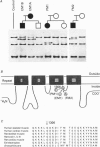Abstract
1. Three families with a form of myotonia (muscle stiffness due to membrane hyperexcitability) clinically distinct from previously classified myotonias were examined. The severity of the disease greatly differed among the families. 2. Three dominant point mutations were discovered at the same nucleotide position of the SCN4A gene encoding the adult skeletal muscle Na+ channel alpha-subunit. They predict the substitution of either glutamic acid, valine or alanine for glycine1306, a highly conserved residue within the supposed inactivation gate. Additional SCN4A mutations were excluded. 3. Electrophysiological studies were performed on biopsied muscle specimens obtained for each mutation. Patch clamp recordings on sarcolemmal blebs revealed an increase in the time constant of fast Na+ channel inactivation, tau h, and in late channel openings as compared to normal controls. tau h was increased from 1.2 to 1.6-2.1 ms and the average late currents from 0.4 to 1-6% of the peak early current. 4. Intracellular recordings on resealed fibre segments revealed an abnormal tetrodotoxin-sensitive steady-state inward current, and repetitive action potentials. Since K+ and Cl- conductances were normal, only the increase in the number of non-inactivating Na+ channels has to be responsible for the membrane hyperexcitability. 5. Length, ramification and charge of the side-chains of the substitutions correlated well with the Na+ channel dysfunction and the severity of myotonia, with alanine as the most benign and glutamic acid as the substitution with a major steric effect. 6. Our electrophysiological and molecular genetic studies strongly suggest that these Na+ channel mutations cause myotonia. The naturally occurring mutants allowed us to gain further insight into the mechanism of Na+ channel inactivation.
Full text
PDF









Images in this article
Selected References
These references are in PubMed. This may not be the complete list of references from this article.
- Cannon S. C., Corey D. P. Loss of Na+ channel inactivation by anemone toxin (ATX II) mimics the myotonic state in hyperkalaemic periodic paralysis. J Physiol. 1993 Jul;466:501–520. [PMC free article] [PubMed] [Google Scholar]
- Cannon S. C., Strittmatter S. M. Functional expression of sodium channel mutations identified in families with periodic paralysis. Neuron. 1993 Feb;10(2):317–326. doi: 10.1016/0896-6273(93)90321-h. [DOI] [PubMed] [Google Scholar]
- Cummins T. R., Zhou J., Sigworth F. J., Ukomadu C., Stephan M., Ptácek L. J., Agnew W. S. Functional consequences of a Na+ channel mutation causing hyperkalemic periodic paralysis. Neuron. 1993 Apr;10(4):667–678. doi: 10.1016/0896-6273(93)90168-q. [DOI] [PubMed] [Google Scholar]
- Fontaine B., Khurana T. S., Hoffman E. P., Bruns G. A., Haines J. L., Trofatter J. A., Hanson M. P., Rich J., McFarlane H., Yasek D. M. Hyperkalemic periodic paralysis and the adult muscle sodium channel alpha-subunit gene. Science. 1990 Nov 16;250(4983):1000–1002. doi: 10.1126/science.2173143. [DOI] [PubMed] [Google Scholar]
- George A. L., Jr, Iyer G. S., Kleinfield R., Kallen R. G., Barchi R. L. Genomic organization of the human skeletal muscle sodium channel gene. Genomics. 1993 Mar;15(3):598–606. doi: 10.1006/geno.1993.1113. [DOI] [PubMed] [Google Scholar]
- Hamill O. P., Marty A., Neher E., Sakmann B., Sigworth F. J. Improved patch-clamp techniques for high-resolution current recording from cells and cell-free membrane patches. Pflugers Arch. 1981 Aug;391(2):85–100. doi: 10.1007/BF00656997. [DOI] [PubMed] [Google Scholar]
- Koch M. C., Steinmeyer K., Lorenz C., Ricker K., Wolf F., Otto M., Zoll B., Lehmann-Horn F., Grzeschik K. H., Jentsch T. J. The skeletal muscle chloride channel in dominant and recessive human myotonia. Science. 1992 Aug 7;257(5071):797–800. doi: 10.1126/science.1379744. [DOI] [PubMed] [Google Scholar]
- Lehmann-Horn F., Iaizzo P. A., Hatt H., Franke C. Altered gating and conductance of Na+ channels in hyperkalemic periodic paralysis. Pflugers Arch. 1991 Apr;418(3):297–299. doi: 10.1007/BF00370530. [DOI] [PubMed] [Google Scholar]
- Lehmann-Horn F., Rüdel R., Ricker K. Membrane defects in paramyotonia congenita (Eulenburg). Muscle Nerve. 1987 Sep;10(7):633–641. doi: 10.1002/mus.880100709. [DOI] [PubMed] [Google Scholar]
- McClatchey A. I., Van den Bergh P., Pericak-Vance M. A., Raskind W., Verellen C., McKenna-Yasek D., Rao K., Haines J. L., Bird T., Brown R. H., Jr Temperature-sensitive mutations in the III-IV cytoplasmic loop region of the skeletal muscle sodium channel gene in paramyotonia congenita. Cell. 1992 Feb 21;68(4):769–774. doi: 10.1016/0092-8674(92)90151-2. [DOI] [PubMed] [Google Scholar]
- Ptacek L. J., Gouw L., Kwieciński H., McManis P., Mendell J. R., Barohn R. J., George A. L., Jr, Barchi R. L., Robertson M., Leppert M. F. Sodium channel mutations in paramyotonia congenita and hyperkalemic periodic paralysis. Ann Neurol. 1993 Mar;33(3):300–307. doi: 10.1002/ana.410330312. [DOI] [PubMed] [Google Scholar]
- Quasthoff S., Franke C., Hatt H., Richter-Turtur M. Two different types of potassium channels in human skeletal muscle activated by potassium channel openers. Neurosci Lett. 1990 Nov 13;119(2):191–194. doi: 10.1016/0304-3940(90)90831-s. [DOI] [PubMed] [Google Scholar]
- Ricker K., Lehmann-Horn F., Moxley R. T., 3rd Myotonia fluctuans. Arch Neurol. 1990 Mar;47(3):268–272. doi: 10.1001/archneur.1990.00530030034012. [DOI] [PubMed] [Google Scholar]
- Rojas C. V., Wang J. Z., Schwartz L. S., Hoffman E. P., Powell B. R., Brown R. H., Jr A Met-to-Val mutation in the skeletal muscle Na+ channel alpha-subunit in hyperkalaemic periodic paralysis. Nature. 1991 Dec 5;354(6352):387–389. doi: 10.1038/354387a0. [DOI] [PubMed] [Google Scholar]
- Rüdel R., Lehmann-Horn F. Membrane changes in cells from myotonia patients. Physiol Rev. 1985 Apr;65(2):310–356. doi: 10.1152/physrev.1985.65.2.310. [DOI] [PubMed] [Google Scholar]
- West J. W., Patton D. E., Scheuer T., Wang Y., Goldin A. L., Catterall W. A. A cluster of hydrophobic amino acid residues required for fast Na(+)-channel inactivation. Proc Natl Acad Sci U S A. 1992 Nov 15;89(22):10910–10914. doi: 10.1073/pnas.89.22.10910. [DOI] [PMC free article] [PubMed] [Google Scholar]
- Yap E. P., McGee J. O. Nonisotopic SSCP detection in PCR products by ethidium bromide staining. Trends Genet. 1992 Feb;8(2):49–49. doi: 10.1016/0168-9525(92)90339-6. [DOI] [PubMed] [Google Scholar]



